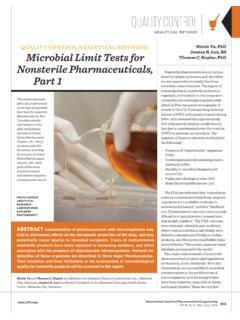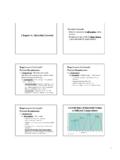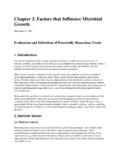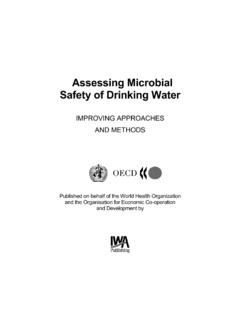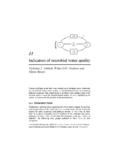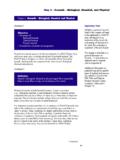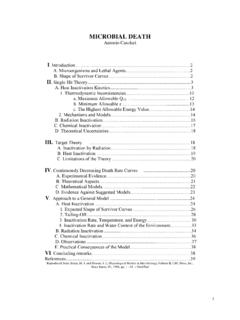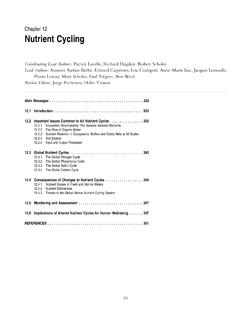Transcription of Quality Control: Microbial Limit Tests for Nonsterile ...
1 Quality Control Quality Control: Microbial Nicole Vu, PhD. Jessica R. Lou, BS. Limit Tests for Nonsterile Thomas C. Kupiec, PhD. Pharmaceuticals, Part 2 Part 1 of this 2-part article contains important facts about the topic of Microbial Limit Tests for Nonsterile pharmaceuticals, including the following statements1: This article represents part 2 of a 2-part article Nonsterile pharmaceuticals are not on the topic of Microbial produced by aseptic processes and, Limit Tests for Nonsterile therefore, are not expected to be pharmaceuticals. Part 1, totally free from Microbial contami- which was published in nations. the International Journal The degree of contamination in non- of Pharmaceutical Com- sterile products is regulated, and is pounding's May-June based on the acceptance criteria for 2014 issue (Volume 18, No.)
2 3), provided an intro- microbiological Quality established in duction to this topic as Pharmacopeial monographs. well as a discussion on the The major contaminants of Nonsterile acceptance criteria for pharmaceutical products and ingredi- microbiological Quality ents are bacteria, yeast, and ,2. of Nonsterile pharmaceu- ticals and an overview of Also, the following excerpt from part 1 of United States Pharmaco- this topic stated1: peia chapter <61>. Part 2 brings us back to this United States Pharmacopeia (USP). topic with an overview of Chapters <61> Microbiological United States Pharmaco- Examination of Non-Sterile Products: peia chapter <62>. Microbial Enumeration Tests and <62>. Microbiological Examination of Non- Sterile products: Tests for Specified Microorganisms provide protocols that allow quantitative enumeration of the presence of bacteria and fungi.
3 The Tests PHOTO SOURCE: help determine whether a Nonsterile Analytical Research Laboratories & product complies with an established Pickens Photography specification for microbiological qual- ity. Additionally, these two USP chap- ters provide guidance on determining Abstract Cases of contaminated Nonsterile products have been the absence of, or the limited occur- reported in increasing numbers. Often, these contaminated products are rence of, specified microorganisms that associated with the presence of objectionable microorganisms. The major may be detected under the conditions of contaminants of Nonsterile pharmaceutical products and ingredients are the Tests .[3] It is necessary to emphasize bacteria, yeasts, and molds. The combination of parts 1 and 2 of this series here that the USP provides methodolo- of articles provides a thorough examination of microbiological Quality gies for selected indicator organisms, but not all objectionable organisms in testing for Nonsterile products.
4 The FDA opinions.[4]. Nicole Vu and Thomas C. Kupiec are affiliated with Analytical Research Laboratories, Inc., Oklahoma City, Oklahoma; Jessica R. Lou is a PharmD Candidate at the Oklahoma University Health Science Center, Oklahoma City, Oklahoma. International Journal of Pharmaceutical Compounding Vol. 18 No. 4 | July | August | 2014 305. Quality Control Part 1 of this 2-part series of articles Table 2. Representative Microorganisms for Use in Validation of provided an overview of USP chapter <61>, United States Pharmacopeia Chapters <61> and <62>.3. as well as a discussion on other chapters within the USP that relate to the microbio- Organism ATCC NCIMB CIP NBRC NCTC NCPF IP. logical Quality of Nonsterile pharmaceuti- Staphylococcus aureus 6538 9518 13276 NA NA NA.
5 Cals. This article provides an overview of Pseudomonas aeruginosa 9027 8626 13275 NA NA NA. USP chapter <62>. Bacillus subtilis 6633 8054 3134 NA NA NA. Candida albicans 10231 NA NA 1594 NA 3179 Overview of United Escherichia coli 8739 8545 3972 NA NA NA. States Pharmacopeia Salmonella enterica chapter <62>: Tests for subsp: serovar typhimurium or 14028 NA NA NA. Specified serovar abony NA NA 100797 6017 NA NA. Microorganisms Clostridium sporogenes 11437 or 12343 100651 or 19404 14293 532 NA NA. USP chapter <62> provides proce- dures and test conditions for determin- ing whether the product under examination meets the acceptance as objectionable (Table 1).3 Alternative methods may be applied if criteria for the specified microorganisms that have been identified their equivalence to Pharmacopeial procedures has been demon- strated.
6 As with all microbiological Tests , growth properties of the Table 1. United States Pharmacopeial ( chapter media must be demonstrated, and the method must show to be suit- <1111>) Acceptance Criteria for Microbiological able for Microbial recovery in the presence of a product using the test strains listed in Table 2. The challenge Microbial species must Quality of Nonsterile Dosage be detected with the same indication reactions described in USP. Absence of chapter <62> under the Testing of Products section. TAMC TYMC Specified Route of (cfu/g, (cfu/g, Microorganism(s). Testing of Products by United States Administration cfu/mL ) cfu/mL) (1 g, 1 mL)a Pharmacopeia chapter <62>. Oral (non-aqueous) 10 10 Escherichia coli The procedure for the preparation of test samples follows the Oral (aqueous) 10 10 Escherichia coli same principle as previously described for Microbial enumeration Rectal 10 10 None designated testing (USP <61>).
7 If neutralization of antimicrobial activities Oromucosal 10 10 Staphylococcus aureus Pseudomonas aeruginosa cannot be accomplished, then it may be assumed that the inhib- ited microorganisms will not be present in the product. In most Gingival 10 10 Staphylococcus aureus Pseudomonas aeruginosa instances, the product is diluted 1:10 in a general purpose medium Cutaneous 10 10 Staphylococcus aureus ( , TSB or SCD broth), and then incubated for a defined time Pseudomonas aeruginosa to resuscitate but not to promote growth of Microbial species in Nasal 10 10 Staphylococcus aureus the product. After the resuscitation step, an aliquot of the sample Pseudomonas aeruginosa solution equivalent to 1 g (or 1 mL) of the product is transferred Auricular 10 10 Staphylococcus aureus to an enrichment medium for culturing under conditions optimal Pseudomonas aeruginosa for growth of the target species, and then sub-cultured on selec- Vaginal 10 10 Pseudomonas aeruginosa tive medium for indication Tests .
8 The properties of selective media Staphylococcus aureus Candida albicans employed in testing by USP <62> are summarized in Table 3. Transdermal Patch (drug matrix, adhesive Staphylococcus aureus Test for Absence of Specified Microorganism layer and backing) 10 10 Pseudomonas aeruginosa USP chapter <62> entails procedures to test for absence of Bile- Inhalation 10 10 Staphylococcus aureus Pseudomonas aeruginosa Tolerant Gram-negative Bacteria, Escherichia coli, Samonella, Bile-tolerant Gram-negative Pseudomonas aeruginosa, Staphylococcus aureus, Clostridia, and bacteria Candida albicans. While most procedures specify a sample volume Pharmaceutical equivalent to 1 g (or 1 mL) of the product, the Samonella test is the substances 10 10 None designated only case that requires that a sample volume equivalent to 10 g (or aMinimum amount of product to be used in sample preparation 10 mL) of the product be used.
9 In the test for Clostridia, a portion of cfu = colony-forming unit; TAMC = total aerobic Microbial count; TYMC = total combined yeasts and molds count the diluted sample is heated to 80 C for 10 minutes and then cooled International Journal of Pharmaceutical Compounding 306 Vol. 18 No. 4 | July | August | 2014. Quality Control Table 3. Properties of Selective Media Used in Table 4. Selective Media and Their Usage in United Testing by United States Pharmacopeia chapter States Pharmacopeia chapter <62>.3. <62>.3 Temperature Time Growth Growth Indicative Test Medium ( C) (Hour). Medium Promotion Inhibition Reaction Bile Tolerant Mossel Enterobacteria Gram-negative Enrichment Broth 30 to 35 24 to 48. Mossel Enterobacteria E. coli Violet Red Bile Glucose Enrichment Broth P.
10 Aeruginosa S. aureus Agar 30 to 35 18 to 24. Violet Red Bile E. coli E. coli E. coli MacConkey Broth 42 to 44 24 to 48. Glucose Agar P. aeruginosa P. aeruginosa MacConkey Agar 30 to 35 18 to 72. MacConkey Broth E. coli S. aureus Samonella Rappaport Vassiliadis MacConkey Agar E. coli E. coli Samonella Enrichment Rappaport Vassiliadis Broth 30 to 35 18 to 24. Samonella Xylose Lysine Enrichment Broth S. enterica S. aureus Deoxycholate Agar 30 to 35 18 to 48. Xylose Lysine P aeruginosa Cetrimide Agar 30 to 35 18 to 72. Deoxycholate Agar S. enterica S. enterica S. aureus Manitol Salt Agar 30 to 35 18 to 72. Cetrimide Agar P. aeruginosa E. coli Clostridia Reinforced Medium for Manitol Salt Agar S. aureus E. coli Clostridia 30 to 35 (anaerobic) 48. Columbia Agar 30 to 35 (anaerobic) 48 to 72.
